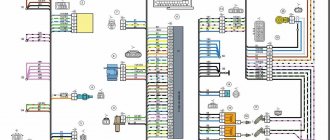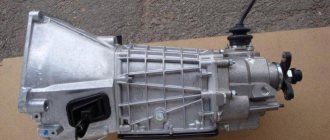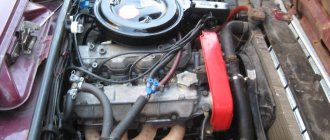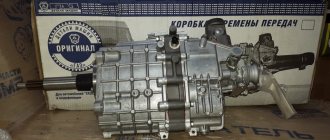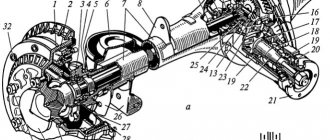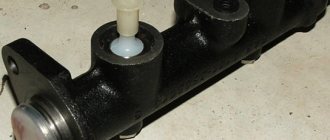Tools:
- Driver for socket attachment
- Extension for the end attachment on the wrench
- 8mm wrench attachment
- 10mm wrench attachment
- High nozzle on the wrench 13 mm
- 15mm wrench attachment
- 17mm wrench attachment
- 19mm wrench attachment
- 30mm wrench attachment
- 32mm wrench attachment
- Torx wrench attachment E12
- Torx wrench attachment E14
- Large flat screwdriver or spatula
- Medium Phillips screwdriver
- Impact screwdriver
- Pliers
- Open-end wrench 10 mm
- 8mm curved box spanner
- 13 mm curved box spanner
- 17 mm straight box spanner
- 19mm straight box spanner
- 8 mm hex key
- Adjustable stop - 2 pcs.
- Large hammer
- Kerner
- Funnel
- Hose
- Technical capacity
- Metal brush
- Jack or ditch lift
- Stand
- Wheel key
- Crafting table
- Beard
- Marker
- Circlip Pliers
- Transmission Bearing Puller
- Mandrel for oil seals
- Thick wire hook
Parts and consumables:
- Grease "CV joint-4"
- Guide pin M12×1.25 mm with a sawn slot for a screwdriver
- Wooden blocks
- Rags
- Rope
- Wire
1. Remove the transmission as described in this article.
2. Clean the outside of it from dirt (do not allow dirt to get inside the box).
3. Remove the oil level indicator.
4. Place the gearbox in a vertical position on the clutch housing on a bench and unscrew bolt 1 with a flat washer, as well as two nuts 3 with a spring washer that secure the clutch cable bracket. Remove this bracket from the gearbox after unscrewing all the bolts.
5. On the cover located at the back, unscrew all the remaining fastening nuts using a 13 mm spanner.
6. Remove the cover. To do this, use a screwdriver (or gently tap the lugs with a hammer) to lift the lug located on the lid.
7. The bolt with spring washer that holds the fifth gear fork should be unscrewed with a 10 mm wrench.
8. Then secure the gearbox shafts from spinning: move the synchronizer clutch and fork down in fifth gear so that the gear and splines of the clutch are connected; then engage third or fourth gear by moving the gear selection rod.
9. Unlock with a bit and unscrew the nut securing the input shaft. To do this, you need to try, because the nut is tightened very tightly.
10. Carry out the operations described in the previous paragraph for the secondary shaft nut.
11. In fifth gear, lift the driven gear using screwdrivers (by doing this, the synchronizer hub is pressed off the shaft). Together with the gear, you need to remove the synchronizer and the secondary shaft fork.
Note:
Be sure to make sure that the synchronizer clutch does not move out and remains on the hub, since the balls that secure the synchronizer may fall apart.
12. Remove the thrust plate from the top of the synchronizer, and then remove the fork from the synchronizer itself in the coupling groove.
13. Also remove the fifth gear and locking ring 1 from the synchronizer. You need to number locking ring 1 and clutch 2, and then remove the ring.
Note:
This must be done in order to put the ring in the same position as it was, because during operation the teeth of the coupling and the ring have already worked into each other. If there is no reason to disassemble the synchronizer, then it must be tied with rope so that it does not fall apart.
14. Remove the bushing from the secondary shaft.
15. The input shaft houses the fifth gear drive gear. It must be removed after remembering its original position.
How to understand that the gearbox input shaft bearing has become unusable?
The gearbox is a reliable component of the machine. The car will most likely go through several engine failures and chassis repairs before it needs work on the gearbox. There are several fairly obvious signs that the bearing in your box has become unusable.
Do you hear noise uncharacteristic of normal operation (“whistle”, “howl”) from the gearbox, and does it occur when the engine is running at neutral speed? This is a sign that the bearing needs to be replaced. If you hear knocking noises from the gearbox while the car is moving and a knocking noise is heard when you turn on any speed, it is most likely a bearing problem. A knocking sound is an obvious sign of bearing failure. Also consider that it is time to remove the gearbox when, when changing gears, shifts begin to be difficult and “cling.” Due to a broken or jammed input shaft bearing, the clutch stops working in any case.
Lada Granta with automatic and robot
After the appearance of the Granta version with an automatic transmission in 2012, which was installed on this model until 2015, many experts agreed that AvtoVAZ really brought to the market a high-quality budget model with an automatic transmission.
In fact, the experience of ordinary car enthusiasts confirms that this is indeed the case. The reason is quite obvious, since VAZ did not experiment and went along the proven path, equipping the Grant with a “classic” 4-speed hydromechanical Japanese automatic transmission.
If you follow all the rules and recommendations for maintenance and operation, such an automatic machine can easily cover 200 thousand km. and more without repair. The main thing is to change the transmission fluid every 40-50 thousand kilometers. As a last resort, replacement is allowed at 60 thousand km. It is also strongly recommended to fill with original ATF EJ-1 or Matic-S oil.
Putting aside the significant increase in price of the Lada Grant with an automatic transmission, the increased fuel consumption, the need for more expensive and frequent maintenance, as well as a slight decrease in acceleration dynamics, otherwise there are no complaints about the automatic transmission on the Grant.
It is important to understand that any torque converter boxes are sensitive to slipping (clutches burn), overheating and large “shock” loads (sharp starts, towing a trailer, etc.).
Also, in some cases, leakage of oil seals and gaskets, damage to the automatic transmission pan due to its low location, as well as contamination of the oil in the machine as a result of active wear of the torque converter locking friction linings were noted.
- Taking into account the disadvantages of the automatic transmission and the high cost of the unit, which led to an increase in the price of the car as a whole, VAZ decided to replace the classic Jatco automatic transmission with the AMT 2182 robotic gearbox.
The specified manual transmission began to be installed on Grant at the beginning of 2015. It is based on a 2180 mechanical transmission, where instead of cables and a clutch pedal, an electromechanical gearbox drive developed by the Germans from the ZF company is used.
As a result, the Lada Granta with the AMT robot has become more economical compared to an automatic transmission, acceleration dynamics have improved, and transmission maintenance costs have decreased. However, such a robot is a cheap solution, which also has disadvantages.
For example, if you drive calmly at first speed and sharply press the gas pedal to accelerate, the transmission “thinks” for quite a long time, is in no hurry to engage second, immediately switching to third gear, etc. In other words, a robot in automatic mode can behave unpredictably, which excludes the possibility of actively using the car and practicing aggressive driving.
At the same time, during a quiet ride, jerks during switching, as well as delays and dips, are kept to a minimum. For lovers of active drive, it is recommended to use the manual shift mode (similar to the Tiptronic automatic transmission).
This mode is semi-automatic, that is, the driver does not fully control the box, as is the case with a manual transmission, but when independently controlled, the manual transmission behaves more predictably in manual mode.
Some owners in this situation are helped by changing the oil in the robotic box, while others still note the presence of extraneous noise to a greater or lesser extent even after this procedure.
Replacing the gearbox bearing
First, to carry out the replacement, the gearbox is removed. Next, you will need to completely or partially disassemble the box. To remove the box basket, you must first disconnect the negative wire of the car's electrical system and disconnect the speedometer sensor. In any case, you will have to disconnect the exhaust pipe (“pants”) of the exhaust gas system. Next, the wizard performs the operations described below.
The box is well cleaned of dirt, its body is checked for defects. The bearing on the shaft is secured with additional retaining rings. The master carefully pries out and unclenches the rings using a flat screwdriver. Among the list of special auto repair tools there is also tweezers for removing retaining rings. Next, you need to pry off the bearing with a screwdriver, while the shaft moves forward. A thin pry bar is inserted between the bearing and the box and the mechanic begins the operation of removing the gearbox input shaft bearing. The bearing is pressed in and needs to be knocked out - with precise, careful and, at the same time, strong blows. In this case, the shaft must rotate. This entire operation is performed by a master with the help of an assistant and can take quite a lot of time, usually up to 30 minutes. Also, the workshop can use a special puller for such cases.
Before replacing the old input shaft bearing, it must be carefully prepared. Preparation involves thorough lubrication. To press the bearing in, you can use a pipe of a suitable diameter or special tools. The worker drives the part into its proper place with precise, uniform and neat blows. After the technician makes sure that the bearing is seated properly (the shaft should rotate lightly and smoothly), the box is assembled in the reverse order and installed back on the car.
The bearing does not always need to be changed; sometimes you can simply lubricate it well. A gearbox is a vehicle component that operates constantly. That is, the smear on the bearing “burns” quite intensely. The reason for the “disappearance” of the lubricant, according to many car owners, is also the synthetic oil poured into the gearbox - it is this that “corrodes” and “washes” the lubricant out of the bearing.
There is no need to rush into purchasing this part (as with purchasing any parts). Its price is low, VAZ bearings cost about 300-500 rubles (you can find them cheaper in advertisements) and that is why purchasing can be difficult. Current traders and manufacturers prefer to sell cheap parts as “repair kits”. The most important thing is what was mentioned at the beginning of the article - the only sign of complete destruction of the bearing is jamming and knocking. If a “whistle” is heard, then most likely it will be enough for you to simply lubricate the part.
When the workshop knocks the bearing off the shaft, check it for grease. For lubrication, it is best to use regular good motor oil, for example, litol - a proven and reliable option. Lubricate the old (and new) bearing by syringing, carefully introducing oil into the working areas, or by dipping into lithol heated in a water bath. Lubrication using the first method takes longer, but the result is better.
Why does noise appear in the gearbox on a Lada Kalina - when you squeeze the clutch, the noise disappears
Car : Lada Kalina. Asks : Makar. The essence of the question : the problem is noise in the clutch, what should I do?
When starting the car when it is cold, a noise is noticeable. As it warms up the noise disappears. But if you immediately depress the clutch pedal, the noise disappears. What is this? I'm afraid that I might get in the way. They told me it was a release.
This is especially noticeable on a cold engine.
The problem is relevant not only for Kalin, but also for the tenth family, Prior, Grant.
Causes of noise in the gearbox
- The most important thing is the release bearing .
A damaged release bearing with traces of rust and no traces of lubricant.
The gearbox input shaft bearing can be replaced only after dismantling the gearbox itself.
To avoid unnecessary problems, you should get into the habit of checking the oil level in the gearbox a couple of times a year. When inspecting the dipstick, pay attention to its integrity. The trouble is that when you engage second gear, an incorrectly inserted dipstick (inserted crookedly) may rub.
A typical breakdown of the clutch fork at the point where the lever attaches to the shaft.
The release bearing is usually replaced along with the clutch disc and basket.
The resource depends on the initial quality of the part and the operating characteristics of the vehicle. If you have to drive frequently in traffic jams, the risk of bearing failure is high.
You can drive with a buzzing release for quite a long time, but eventually the bearing will still crumble or jam.
The hum appears because the bearing rotates when the engine is running . But no effort affects it. Therefore, even a slight play can cause extraneous sound. It is not possible to lubricate the bearing - it is a closed type and access to it is problematic. Only a complete replacement will help.
When the clutch is depressed, a load is applied to the bearing, therefore, the backlash decreases. For this reason, the sound may disappear.
- But this can be observed only in the early stages of the destruction of the part. Subsequently, a metallic crunch appears. Often the bearing falls apart into several parts.
All that's left of the release. By the way, these fragments can seriously damage the clutch basket.
Replacing the release bearing
To replace the release bearing, at a minimum, you will have to be patient and drive the car into the inspection hole.
To replace the release bearing, you will need to remove the gearbox.
The work is complicated - it is necessary to disconnect the rocker, dismantle the clutch drive, starter, and attachment to the body.
The drives are disconnected one by one, and the differential mechanism is fixed using any guide. After this, the gearbox fastenings to the engine block are unscrewed and the box is removed.
Other
A humming sound due to a broken bearing on the input shaft can only be eliminated after removing the box and replacing the element . Adjustment will be required. But in practice, extraneous sound rarely appears for this reason; more often it is the fault of the release valve . Also, a hum can be observed from the gearbox due to low oil level or quality. In this case, it must either be topped up or replaced .
How to find a good craftsman to carry out this work at the proper level of quality?
As you can see for yourself by reading the text above, replacing the gearbox input shaft bearing is a very labor-intensive operation, and the payment according to generally accepted standards and rates that workshops are guided by is not at all generous.
Therefore, let’s face it, service stations “don’t like to do such work.” They either impose additional services on the client or double the price. Many workshops do not have this service at all; it falls under the category of “gearbox repair” and you can pay for replacing one bearing as if you were paying for a complete overhaul of the gearbox. Of course, you still have to pay the craftsmen for such tedious work. If it comes to the provinces, then today the cost of work is about 3 thousand rubles (summer 2022) - 1 thousand to remove the gearbox, 1 thousand to put it back, 1 thousand for the bearing. In the capital, the cost can be 4500-5000. It is within these limits that you need to navigate. If you were asked for about 10,000 rubles, it means that you are being offered to pay for a complete overhaul of the box.
Try our service station selection service
Creating an application is absolutely free and will take you no more than 5 minutes
In any gearbox, as in almost every mechanical device with rotating parts, there are up to 12 or more rolling bearings. Read all about gearbox bearings, their types, design and characteristics, as well as the correct selection and replacement of these parts.
Which transmission is suitable for the Lada Granta?
For decades, all front-wheel drive Ladas were equipped with approximately the same boxes with only minor changes. The Granta is suitable for gearboxes from 2108, 2109, 21099, 2110, 2111, 2112, 2113, 2114, 2115, Priora, Kalina. If your transmission has broken down because you like to “push your shoe to the floor,” then it is recommended to install a “nine” box. It is more tenacious, but noisy.
There were still certain differences. From the very beginning until 2010, Sputnik and Samara had the same transmission. On 2110, 2111 and 2112 there was a modified gearbox. The differences were in the gear selection mechanism, clutch fork and brackets.
The transmission from the “ten” ends up in the Priora in a modified form under the index 2170. Then this gearbox is modified, and in 2013 it debuts under the index 2180 and is installed on the Kalina, Priora and Granta. Therefore, the checkpoint from “Priora” to “Grant” will also easily fit. The gearbox from the Kalina will also fit on the Grant without question, just like the slightly different gearbox from the Lada Granta Sport.
Compatibility Criteria
The new gearbox from the "ten" will fit on the rocker "Grant" without any problems, since the first "Grants" had a modified gearbox from 2110. Therefore, the gearbox from the VAZ 2110 will fit on the "Grant". In the case of a cable box, some difficulties will arise. Since a larger diameter clutch is used, the clutch basket will also have to be changed.
What is a gearbox bearing?
Gearbox bearing (gearbox bearing) is a part of the gearbox of automotive equipment; a rolling bearing of one design or another, acting as supports for gearbox shafts and gears.
In a gearbox, depending on its type, number of gears, method of transmitting torque between elements and design, from 4 to 12 or more bearings of various types can be used. Bearings solve several problems:
- Performing support functions for all or only individual shafts (in most cases - two supports for all shafts, in some boxes there are simpler or more complex schemes - one support for the primary shaft, three supports for the secondary shaft, etc.);
- Acting as a support for gears mounted on the secondary shaft (in gearboxes with synchronized gears and gears freely rotating on the secondary shaft);
- Reduced friction forces in the bearings of shafts and gears (reduced torque losses in the transmission, reduced heating of its parts).
The use of bearings ensures the correct installation of the moving components of the gearbox and greatly reduces the friction forces arising between these parts. The operation of the gearbox, its ability to normally transmit and change torque, and generally ensure vehicle controllability, depend on the condition and characteristics of the bearings. Therefore, worn and faulty bearings must be replaced, and in order to make the right choice of these parts, it is necessary to understand their design, types and applicability.
P O P U L A R N O E:
- Diagram of a car radar detector.
Antiradar circuit.
Converting the valve from a washing machine to 12 volt DC power supply
Electric valves are required to automatically control various hydraulic systems. Finished products are quite expensive. Let's look for a cheaper solution.
Recently, amendments to the traffic rules were introduced in Russia, one of which is: driving during the day with low beam headlights, fog lights or
daytime running lights . Now you need to drive with lights on during the day. Driving with low beams or fog lights on additionally creates a load on the generator, reduces the service life of the lamps, and also increases fuel consumption (more than 0.5 liters per 100 km). Therefore, it is better to drive during the day with the running lights turned on, the light-emitting element of which is LEDs , which consume much less power than incandescent lamps. You can buy DRLs, or you can make them yourself from scrap materials.
Types, design and characteristics of gearbox bearings
In automobile, tractor and other transport gearboxes, standard rolling bearings of several main types are used:
- Ball single-row radial and radial contact;
- Double-row angular contact balls;
- Roller single row radial;
- Roller conical single row;
- Single-row and double-row needle rollers.
Each type of bearing has its own characteristics and application in gearboxes.
Ball single row radial. The most common bearings that can be used as supports for all gearbox shafts. Structurally, it consists of two rings, between which there is a row of steel balls in the separator. Sometimes the balls are sealed with metal or plastic rings to prevent loss of lubricant. Bearings of this type work best on relatively lightly loaded boxes of passenger cars and motorcycles, but are sometimes found on some shafts of cargo boxes.
Single-row angular contact balls. These bearings normally accept radial and axial loads; they are most often used as rear supports of the primary and secondary shafts, which during the operation of the gearbox can be subject to loads directed along the axis (due to the movement of the synchronizers and their support in the gears). Structurally, an angular contact bearing is similar to a radial bearing, but its rings have stops that prevent the structure from collapsing under axial loads.
Double-row angular contact balls. Bearings of this type are more resistant to high loads, so they are usually used as a rear support for the input shaft and sometimes for the intermediate shaft. The design of such bearings is similar to single-row ones, but they use wide rings with external stops for the balls.
Roller single row radial. These bearings can operate under higher loads than ball bearings, so they are used as supports for all shafts in the gearboxes of automotive and tractor equipment - trucks, tractors, special equipment, agricultural machinery, etc. Structurally, bearings of this type are similar to ball bearings, but they use rollers as rolling bodies - short cylinders, together with a cage, sandwiched between rings with flat inner surfaces.
Seller's comment
Special conditions: • Discount for purchases on credit up to RUB 15,000. • Discount for CASCO insurance up to 20,000 rubles. • Discount for trade-in up to 15,000 rubles. • Maximum discount of 50,000 rubles.
ID-1594/№44 The car is in excellent condition. Timely service. Careful operation. The salon is clean, well-groomed, and smoke-free. Pre-sale preparation and technical diagnostics have been carried out, no additional investments are required!
Call, or better yet, come right now! We are glad to see you! Become part of our large family of regular customers! UNIQUE OFFER FOR ALL CARS. When you return your car under the Trade-in program, an additional discount of up to 50 thousand rubles * According to our expert assessment, the mileage of this car is not confirmed.
The AUTO-FULL car dealership invites you to pick up your new used car!
Opening hours: Every day from 9-20.
Advantages of our car dealership: - Convenient free parking for our clients. — There are always more than 100 used cars on sale — Cozy customer area. Children's corner with photo studio. — Upon receipt of the warehouse, all cars undergo a thorough check and pre-sale preparation at 103 points. — Guarantee of legal purity for each car. — Applying for a loan within an hour using 2 documents. More than 10 partner banks. — Free test drive before purchase. — At your request, our manager will send you additional photos and videos in any convenient way. — Profitable exchange of your car using the TRADE-IN system. — Purchase of any cars, incl. pledged by any bank in the Russian Federation.
Unlike the front, it has undergone virtually no changes. Here, just like on the first Soviet G8s, a semi-independent beam is used. It is attached to the body on hinges (fortunately, there are no “crabs” in the design). A helical spring with constant stiffness is used as an elastic element. To dampen vibrations and prevent swinging, two shock absorbers are used.
- High reliability. The design does not have additional levers, which, in addition, can bend when falling into a large hole.
- Energy intensity. The Lada Granta absorbs all bumps perfectly, especially if oil shock absorbers are installed at the rear.
- Cheap maintenance. Due to its simple design, this pendant can be rebuilt even with your own hands. And the cost of new rubber-metal elements is unlikely to empty the pockets of even the most stingy car owner.
The main difference between the “Grant” suspension is the wheel alignment angles.
Issues of correct selection and replacement of gearbox bearings
As a rule, routine maintenance activities do not include operations to replace gearbox bearings - this is performed as necessary in the event of wear or destruction of parts. The need to carry out such repairs may be indicated by extraneous noises and even knocks from the gearbox, spontaneous switching on and off of gears, an incorrectly functioning or jammed clutch, and generally deteriorated transmission performance. In all these cases, it is necessary to carry out diagnostics, and if a malfunction is detected, replace the bearings.
Replacement bearings should only be of the types and sizes that were installed on the box by the manufacturer. It is best to select the required bearings using parts catalogs or specialized reference books, which indicate the catalog numbers and types of all bearings for this particular box, as well as acceptable analogues of parts. You can buy bearings separately, but in some cases - for example, to overhaul a box - it makes sense to purchase complete sets of parts for a specific model of the unit.
Replacing bearings in most cases requires dismantling and almost completely disassembling the gearbox (an exception is replacing the input shaft bearing in some gearboxes, for which the unit only needs to be removed from the vehicle, but does not need to be disassembled). This work is quite complex and requires the use of special tools (pullers), so it is better to trust it to specialists. If the box repair is carried out correctly and in accordance with the instructions, the unit will stop causing problems, increasing the controllability and comfort of the car.
Transmission oil Suprotek Atomium - a universal soldier in manual transmission
As discussed above, half of the problems with gearbox noise and hum are associated with low-quality transmission oil or insufficient filling. For vehicles with a manual transmission, it is recommended to use Suprotek Atomium transmission oil on a fully synthetic basis. This allows you to achieve stable operating properties throughout the entire service life. The peculiarity of this transmission oil is that it practically does not break down when heated, does not oxidize, does not burn at all and does not evaporate. In addition, the mineral impurities included in the composition absolutely do not enter into chemical reactions with wear products, fuel or other additives.

